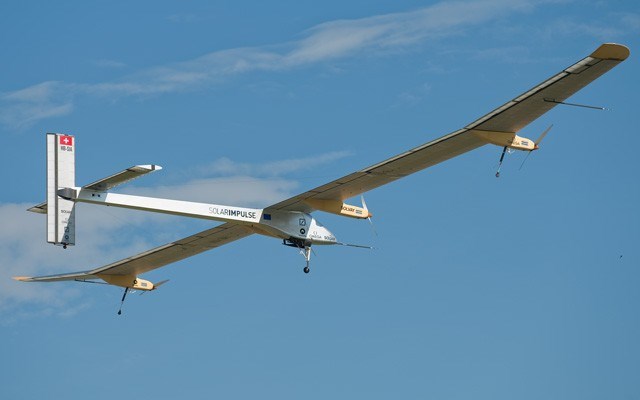As I write this, Solar Impulse completed its remarkable journey: the first round-the-world flight by an aircraft that uses no fuel except sunlight. Pilot Bertrand Piccard landed in Abu Dhabi this week to global acclaim. And you can't help wondering: is this the future of flight?
There are about 100,000 commercial flights per day, and the aviation industry burns just under 300 billion litres of fuel each year. Commercial aircraft are responsible for about two per cent of the human race's carbon-dioxide emissions.
So electric airplanes that burn no fossil fuel would be very helpful, and Bertrand Piccard thinks that this is indeed the future. "I make the bet that in 10 years we will have electric aeroplanes flying with 50 passengers for short- to medium-haul flights," he said.
"You can fly with no pollution and no noise, and land in urban airports, making no disturbance for the neighbours... And maybe sometime people will say this all started with a crazy idea of flying around the world in a solar aeroplane, and the outcome was useful for everyone."
But Solar Impulse, with the wing-span of a jumbo jet, can carry just one person. Photoelectric cells on the wings power it during the day, and recharge the batteries that take it through the night (barely) — but its average speed is only 75 km/hr, and it took 17 flights and 15 months to travel around the world, so we are still a long way from the Promised Land.
You can't just scale Solar Impulse up and get an electric-powered commercial aircraft that carries 50 people, let alone the 500 passengers that they can jam into a long-haul 747 or A380. The basic problem is coming up with light weight, high-capacity "traction" batteries — ones designed to provide the main power for large vehicles for a period of hours — and progress on this front has been very slow.
Traction batteries are still nowhere near the weight-to-power ratio that would be needed for an airliner, and there are no signs of an imminent breakthrough. Solar Impulse may equal a Boeing 747 in size, but it weighs only 2 tonnes. (The empty weight of a 747 is 129 tonnes.) So we should not expect electric airliners any time soon, and people are not going to stop flying voluntarily. Is there any hope out there?
Maybe so. Aviation fuel has always been derived from petroleum because no other energy source provides as much power for the same weight. (There are no coal-fired aircraft.) But what the engines need is just a high-octane fuel; they don't care where it comes from.
There are two other places it might come from. One way is by growing oil-rich algae in giant vats (salt water or waste-water will do), and crushing it to separate the oil, which can then be refined in the usual way to extract an octane fuel. Exxon Mobil and Synthetic Genomics have spent $100 million on this project since 2009, but they still have much work to do in creating the fast-growing, high-oil-content algae that would make it commercially viable.
The other way is by taking carbon-dioxide directly out of the air, and using a catalyst to combine it with hydrogen to create an octane fuel. Several teams have working prototypes of machines that will extract the carbon dioxide from the air at a modest cost in energy, and the hydrogen can be obtained just by splitting water molecules.
In both cases burning the fuel will, of course, produce carbon dioxide, but it will be precisely the same carbon dioxide that was originally taken from the air to combine with hydrogen or grow the algae — so the process as a whole is carbon-neutral. Since this approach would not require replacing or even modifying the entire 25,000-strong fleet of commercial aircraft, it is certainly more promising for the short and medium term.
There is another potential environmental problem linked to fuel-burning aircraft, and that is the "contrails" (condensation trails) they often leave behind them. The contrails are formed by water vapour from the engine exhaust that freezes when the humidity is high and the air temperature is low, usually in the upper troposphere. They can last a long time and spread out until they turn into cirrus clouds covering large parts of the sky.
Such clouds let most sunlight pass through inbound, but reflect heat back to the surface in the night-time. How big an impact contrails have on global warming is still not settled, but it may be as big as the effect of carbon dioxide from aviation fuel. Conventional aircraft can only avoid contrails by flying lower, which means higher fuel consumption and much more turbulence — but electric aircraft would not leave contrails at any altitude.
So congratulations to Piccard and Solar Impulse's other pilot, Andre Borschberg. Maybe we will have electric airliners one of these days, if only somebody can come up with the right battery — but in the meantime we should be working hard on making carbon-neutral fuel.
Gwynne Dyer is an independent journalist whose articles are published in 45 countries.




